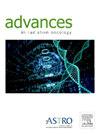序贯90Y选择性内放射治疗(SIRT)和基于90Y pet吸收剂量图的立体定向体放射治疗(SBRT):一项1期研究的中期分析
IF 2.7
Q3 ONCOLOGY
引用次数: 0
摘要
目的选择性内放射治疗(SIRT)可导致非均匀吸收剂量覆盖。为了解决SIRT潜在的剂量不足问题,我们设计了一项1期临床试验(NCT04518748),在90Y SIRT后6周增加立体定向全身放射治疗(SBRT)。方法和材料在这项正在进行的单中心前瞻性试验中,患者接受标准护理90Y SIRT玻璃微球治疗不可切除的原发性或继发性肝癌。使用90Y正电子发射断层扫描/计算机断层扫描进行sirt后剂量测定,计算平均病变吸收剂量。如果平均吸收剂量为290 Gy,则认为病变符合SBRT治疗的条件。在存在剂量异质性的情况下,基于先前建模确定的SIRT剂量阈值,SBRT总肿瘤体积可选择性地限制为亚体积。在10名参与者同时接受SIRT和SBRT并完成6个月的随访后,预先指定中期分析,主要终点Child-Pugh评分增加≥2。结果在24例接受SIRT治疗的患者中,15例患者的病变在剂量学上符合SBRT治疗的标准,即从90Y开始的平均吸收剂量为290 Gy。其中,10名患者接受处方剂量在30至50戈瑞之间的SBRT治疗。只有1例患者在SBRT后6个月Child-Pugh升高≥2,SBRT后仅报告1例3级非实验室毒性。中期分析发现,90Y SIRT后SBRT的肝毒性低于早期停止阈值,建议继续研究以完成30例可评估患者的招募。本文章由计算机程序翻译,如有差异,请以英文原文为准。
Sequential 90Y Selective Internal Radiation Therapy (SIRT) and Stereotactic Body Radiation Therapy (SBRT) using 90Y PET-based Absorbed Dose Maps: Interim Analysis of a Phase 1 Study
Purpose
Selective internal radiation therapy (SIRT) can result in heterogeneous absorbed dose coverage. To address potential underdosing of lesions with SIRT, we designed a phase 1 clinical trial (NCT04518748) to add stereotactic body radiation therapy (SBRT) 6 weeks after 90Y SIRT.
Methods and Materials
In this ongoing, single-center prospective trial, patients received standard-of-care 90Y SIRT with glass microspheres for the treatment of unresectable primary or secondary liver cancer. Post-SIRT dosimetry was performed using 90Y positron emission tomography/computed tomography to calculate mean lesion absorbed doses. Lesions were considered eligible for SBRT treatment if the mean absorbed dose was <290 Gy. In the presence of dose heterogeneity, SBRT gross tumor volumes were optionally limited to subvolumes based on a SIRT dose threshold determined from prior modeling. Interim analysis was prespecified after 10 participants received both SIRT and SBRT and completed 6-month follow-up with the primary endpoint of an increase in Child-Pugh score of ≥2.
Results
Of the 24 patients who received SIRT as part of the trial, 15 had lesions that were considered dosimetrically eligible for SBRT based on the criteria of 290 Gy mean absorbed dose from 90Y. Of those, 10 patients received SBRT with prescription doses between 30 and 50 Gy. Only 1 patient had a Child-Pugh increase of ≥2 at 6 months following SBRT, and only 1 grade 3 nonlaboratory toxicity was reported after SBRT.
Conclusions
Interim analysis found that liver toxicity from 90Y SIRT followed by SBRT was below the early stopping threshold, and continuation of the study to complete recruitment of 30 evaluable patients was recommended.
求助全文
通过发布文献求助,成功后即可免费获取论文全文。
去求助
来源期刊

Advances in Radiation Oncology
Medicine-Radiology, Nuclear Medicine and Imaging
CiteScore
4.60
自引率
4.30%
发文量
208
审稿时长
98 days
期刊介绍:
The purpose of Advances is to provide information for clinicians who use radiation therapy by publishing: Clinical trial reports and reanalyses. Basic science original reports. Manuscripts examining health services research, comparative and cost effectiveness research, and systematic reviews. Case reports documenting unusual problems and solutions. High quality multi and single institutional series, as well as other novel retrospective hypothesis generating series. Timely critical reviews on important topics in radiation oncology, such as side effects. Articles reporting the natural history of disease and patterns of failure, particularly as they relate to treatment volume delineation. Articles on safety and quality in radiation therapy. Essays on clinical experience. Articles on practice transformation in radiation oncology, in particular: Aspects of health policy that may impact the future practice of radiation oncology. How information technology, such as data analytics and systems innovations, will change radiation oncology practice. Articles on imaging as they relate to radiation therapy treatment.
 求助内容:
求助内容: 应助结果提醒方式:
应助结果提醒方式:


